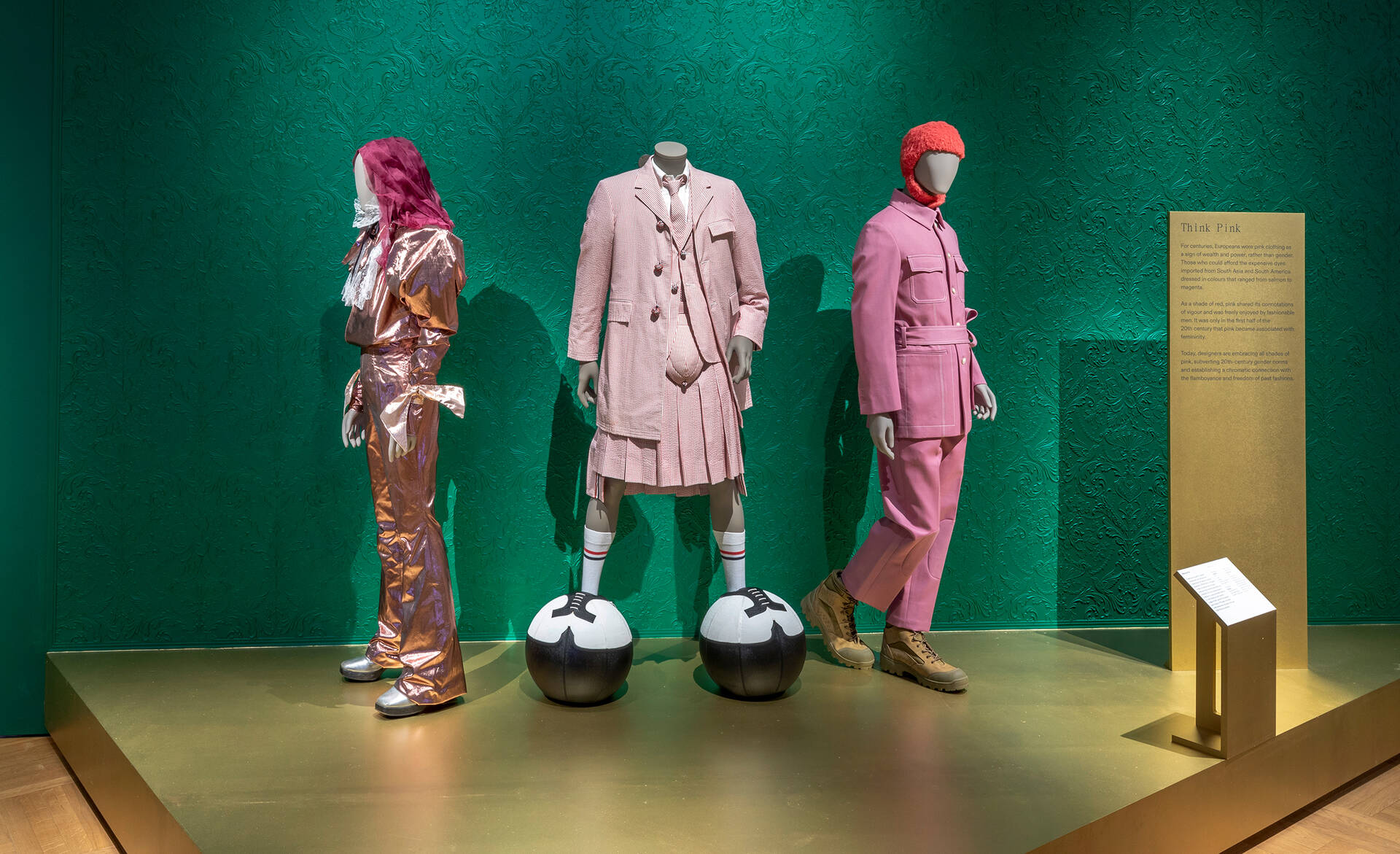Painted by Sir Joshua Reynolds around 1773-4, the 1st Earl of Bellamont is flanked by swags of silk fringed in bronze. His pale fist pressed to his hip, leg cocked, he sports a colossal ostrich feather headdress, rococo style cape and beribboned slippers. On display as part of the V&A’s first major exhibition devoted to masculine attire, the pigment of his scarlet ensemble has faded to a more millennial hue. The reputedly vain and pompous Earl is now both patriarchal pinup and camp icon.
Reynolds rarely painted dress in detail because he considered fashion too transient – yet it is exactly this ephemerality of material and meaning that curators Claire Wilcox and Rosalind McKever were excited to uncover. In Fashioning Masculinities: The Art of Menswear, they position more than 100 garments amongst Renaissance paintings, sculpture, iconic photographs and pieces of canonical film and performance art. They reveal the kinship between historical artifacts and our modern-day anxieties about gender, sex and identity.
It was whilst writing about the history of bags and pockets in the mid-1990s that Wilcox started to rummage through the museum’s collection with a keen, investigative eye. ‘I realised that often, wherever there is art, there are people and wherever there are people, there is clothing. If you journey through the V&A that's what you see: objects placed in context with other objects, so I spend a lot of time looking for little clues,’ she says.
The first room – Undressed – explores classical European ideals of masculinity, perpetuated by the brawny athletes of Athenian sculpture and Calvin Klein’s muscular pin-ups who dominated much of the 1990s. The second space – Overdressed – is where contemporary mores are unleashed. Filled with 18th century and more recent garb, it curiously omits anything hailing from the 19th century. ‘A huge gap exists in history when men were simply not celebrating the decorative potential of clothing,’ Wilcox explains. She describes the tailored suit – which is the focus of the third and last room – as a dominant force that has shaped much of how we read masculinity today. It's rational, it's practical. It can be tailored to any body shape. ‘In some ways, the suit is the most democratic and the most abstract form of clothing there is. It was so successful as a kind of a viral form of dressing that it really knocked all of the decorative inconveniences out of the window,’ she says.
Yet designers have recently returned to the flourish of a frill. Both Edward Crutchley and Harris Reed happily snub male mass conformity – each has an opulent look in the show. Elsewhere, Gianni Versace’s quilted black leather women’s coat from A/W 1992 appears to take on the shape of the doublet and hose sported by Dudley, the 3rd Baron North, a portrait of whom from 1615 is hung nearby. An aristocratic sitter in an oil painting by Jean-Baptiste Perronneau is displayed alongside a mohair ensemble by Grace Wales Bonner in a section devoted to that most infamous of colours: pink. McKever says: ‘The show is our way of bringing art and fashion, past and present together in a way that hopefully opens things up.’
That younger generations are now fixated on ending staid notions of gender only heightens the urgency of the questions posed. ‘One of the first things I did before working on the show was walk around the museum and witness the presence of menswear and masculinity across the whole of the V&A. Even the facade of the building has busts of great artists across it and, of course, they are all male,’ McKever smiles. ‘This is an opportunity to see the museum afresh in terms of how ideas of fashion and gender are displayed both across and within the building.’
Menswear is something the V&A has touched upon before, most notably with Andrew Bolton’s provocative Men in Skirts show from 2002, but this new survey uncovers an even grander parade from Beau Brummell to Bimini Bon-Boulash. Wilcox explains that in the 18th century, men’s silk brocade waistcoats were made from women’s skirts – an example of a textile that’s not only been recycled but re-gendered. ‘Fashion, as we know, is cyclical but so is the reuse of textiles, ideas and patterns. It is the readings of them that might change. We had a choice to do a straight narrative about the history of menswear from A-Z, but we decided to draw on representations of masculinity through the wider collection and we uncovered so many delightful nuances. In many ways, this exhibition feels like the beginning of a journey, not the end of one.’


